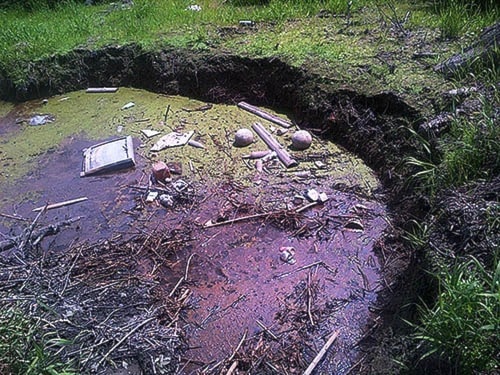The City of Pitt Meadows has vowed to clean up its act when it comes to how it deals with waste from its ditches.
The city regularly clears sludge and evasive weeds from its irrigation ditches to prevent flooding.
The sludge is then dumped in three-metre-deep holes, dug out along the banks of the dike trail by the Alouette River, near Neaves Road, to dry.
The dried dirt is then used to fill in low spots around the dike.
However, some garbage – such as an old TV set, soccer balls, plastic containers and discarded building materials – also ends up in the ditches throughout Pitt Meadows, and ultimately ends up in the dumped mix.
Jack Emberly, a local environmentalist, has taken photos of the dug-out “cells” and is concerned garbage is being left and buried along the dike.
He brought the matter to Pitt Meadows Mayor Deb Walters and council on June 25, hoping the city removes the garbage.
Emberly believes the dumping practice has been common over the years and said there’s no way of telling how much garbage has been buried along the dikes.
Walters has instructed staff to address the issue.
A report is due back to council for its next meeting on Tuesday, July 9.
“I was concerned. I certainly don’t want to see anything that can be environmentally damaging,” said Walters.
“Our No. 1 priority is to make sure the water can flow through our ditches properly.”
Randy Evans, operations superintendent for the City of Pitt Meadows, said the initial process of cleaning the ditches doesn’t allow for garbage to be separated before dumped at the fill site.
“This isn’t something we choose to do. It’s a byproduct off the process,” said Evans. “I wish people wouldn’t dump it on the side of the road, but it’s one of those things we have to deal with.”
He said once garbage is located at the site, it’s pulled, then piled in order to dry out before it’s eventually taken to the landfill or recycling station.
Evans said staffing levels can sometimes dictate how often that occurs, and the amount of garbage varies depending on the day.
“From time-to-time, we can get behind, either it’s three weeks or three months. But we do get the job done,” he said.
While he can’t control the public’s perception of the process, Evans stressed that the goal is to recycle and remove as much garbage as possible.
“I understand, from an optics point of view, that we have to do a better job, and we’ll try to get out there more often.”
Emberly is hoping council will establish a clear policy to deal with the garbage.
“This is a chance for council to become more accountable and more responsible for the policies it puts in place,” he said.
